In this last post of my Backup Basics series, we’ll be taking a closer look at cloud storage. What it is? Why would you want to use one? And what you should be looking for in a good service provider? If you haven’t already read the first four parts, you can do that here (Part 1 – The Different Types of Backups), here (Part 2 – What’s Your Backup Strategy?), here (Part 3 – Why Syncing isn’t Always such a Good Idea), and here (Part 4 – Automatic Backups). On to part 5….
What is the Cloud?
The “cloud” is simply a fancy term for “a bunch of servers.” In essence, the cloud (and the internet) is made up of a bunch of servers that are stored in different places, and all connected to each other through networks. Google Photos, Amazon Prime Photos, Dropbox Photos, and Forever are good examples of cloud-based storage providers. When you create a cloud account with a company, you’re paying for a little slice of space on one of those servers, and you access that space through your internet browser. You’re basically renting (or buying) a virtual storage locker. One of the biggest content network providers (i.e. server homes) is Amazon S3 (yes, that Amazon), which thousands of professional companies use, for example Smugmug, and up until very recently, Dropbox.
Pros of Using the Cloud
There are a lot of pros to using cloud backups, and in my opinion, the pros outweigh the cons… if you choose wisely.
Easy Setup
Setting up a cloud account is pretty simple. For one, you don’t have to invest in any equipment. You don’t have to pick out a hard drive, and you don’t really have to know how to set it up. The company will guide you through all of that. And if you need more help, guess what? They have an FAQ section, and a customer service phone number for you to call. Most cloud service providers will also give you the option to implement an automatic backup system right away. Set it up once, and it keeps running in the background. All you have to understand is how your files are being backed up, so that you can create an efficient backup strategy.
It’s an Off-Site Backup
Another pro of the cloud backup is that it’s off-site, meaning that even if something happened to your computer, nothing would happen to your cloud account. You use your computer to access it, but the cloud and your computer are not connected to each other. Most cloud providers have triple-backup security on their data, which means they use servers that are located in different parts of the world. It’s unlikely that all of a company’s servers will malfunction at the same time, unless there is a major global meltdown.
Cloud Collaboration Works
The cloud is great for collaboration, and especially for someone like me whose family is scattered over several different continents. The cloud makes it easy for me to share memories with family members in other places, and to collaborate with them in real time. As long as there is an internet connection, we’re in business.
The Convenience is Unbeatable
The cloud is amazingly convenient. I love being able to curate photo collections with complete disregard for my physical location. Have I organized photos on a beach? Yep. In a foreign city? Of course. At the airport? You bet. Can’t do that without the cloud. I love that I can travel anywhere and still have everything I need with me.
Cons of Using the Cloud
The cons of cloud backups are few, but they are important. Apart from the global meltdown scenario, here are a few things to think about when you’re choosing your service provider:
Premium Pricing
There will usually be a monthly subscription cost, or a larger fixed cost, to set up your account. The market value of a gigabyte (GB) is much higher in the cloud compared to a local storage device. As an example, buying a 1TB (1000 GB) external hard drive on Amazon will cost you less than $100, but buying a 1TB cloud storage account can cost you well over $1000. Some of the more premium accounts go for up to $4000/TB. Huge difference.
Shut-downs, Mergers, & Acquisions
It’s not uncommon for cloud companies to shut down, or get acquired by another company. This happened just recently with Copy.com, and it’s happened to countless cloud services in recent years. The market is still settling. A recent study from Gartner showed that over 25% of cloud service providers shut down within a few years for various reasons. If your service goes belly up, what happens to you photos? In most cases, they’ll give you a few weeks notice so that you can get your content downloaded, but that’s something you’d have to verify in the terms of service agreement you signed.
Accidents Happen
Sometimes things get deleted. It could be your fault, it could be theirs. But it doesn’t really matter, does it? As I wrote in a past blog post, syncing problems can easily arise in the cloud. I highly recommend that you read this article here, and this article here because they both illustrate how easily these things can happen.
On the other hand, sometimes things don’t get deleted. Let’s say you have uploaded something that you really don’t want saved. If you delete it, is the file really deleted from the company servers? It should be… but is it? How can you be sure? It’s worth checking this stuff out before you decide on which service to pick because, whoops, sometimes things don’t get deleted. I wrote a more in-depth post on your digital rights a while ago, which you can read here.
No Internet, No Access
If you have no internet, you have no access to the cloud, and this is precisely why the cloud doesn’t make a great DPH just yet. I’m a firm believer that your memories should be accessible to you at all times without the need for subscriptions. Don’t you agree? In a few years, maybe, but I don’t think we’re there yet.
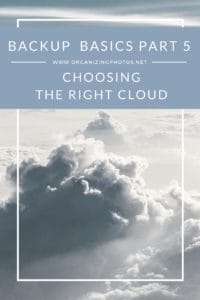
I’m a Perfect Pinnable!
The Cloud Interface
Apart from understanding the policies of the cloud service you want to use, the other big part is figuring out what type of user interface you need. You have to take into consideration who will be using it and their tech levels, but also the key question, which is: Am I saving files, or am I saving stories?
There are three basic types of cloud interfaces: the file & folder structure, the “good enough” basic photo storage interface, and the complete family archive interface.
The File & Folder Structure
This system mimics your computer folder structure in its layout, so that it feels familiar to you. All you see is the name of the file, the size, and what folder it’s in, and you work with it just like you would on your computer. If you’re not going into your account to actually view your files (i.e. you’re just keeping it as a backup), this is all you need. Good examples of the file & folder structure include Dropbox Basic, Google Drive, and most major auto-backup solutions, like Backblaze.
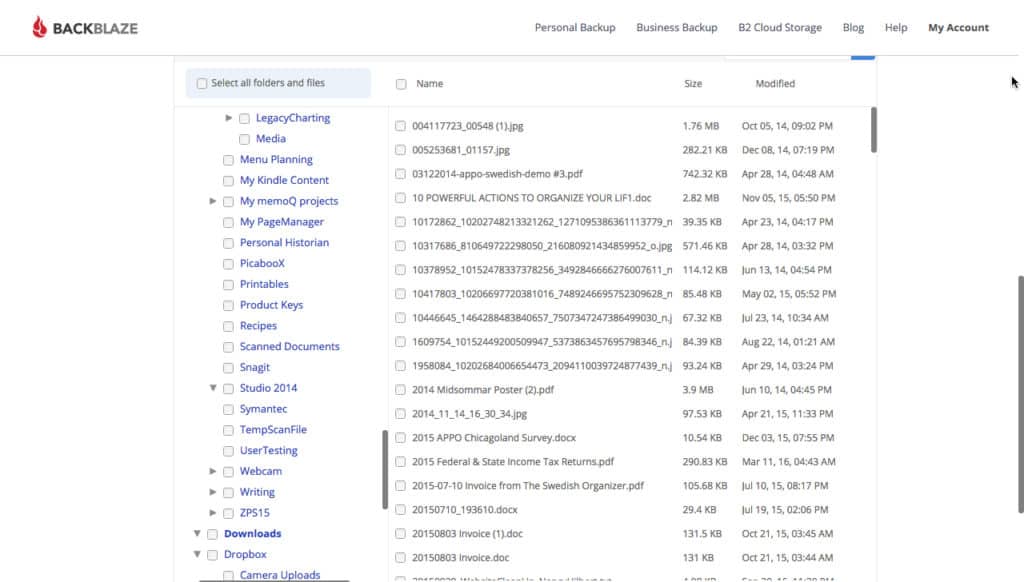
Backblaze is a cloud backup provider that has just a simple file-and-folder structure! You don’t go there to visit your photos… it’s just a backup! There’s no photo viewing and it has limited organizing features.
The “Good Enough Photo Storage” Interface
This one’s fun because it’s more of a recent development. After figuring out that many people actually store photos in their cloud accounts, companies like Google, Amazon, Dropbox etc., have decided to make the interfaces just a little bit prettier for their users. It’s still not great, but it’s good enough. This type of folder structure lets you actually view your photos head-on (sometimes even in a slideshow). There are usually a few more organizational features available (yay), but you won’t be able to put in your stories, or save your metadata safely.
In many cases, the terms of use agreements are what spoil these types of services, not the actual interface. A few good examples of this type of interface can be found with Dropbox Photos, Google Photos, and Amazon Prime Photos.
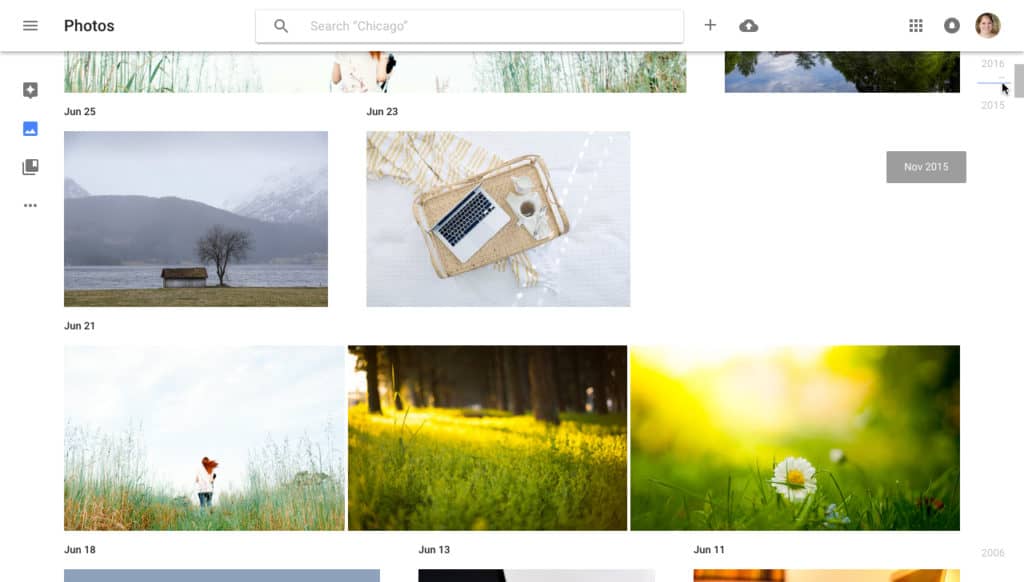
Google Photos: An example of a “good enough photo storage” interface option. You can create albums and view photos in different ways, but don’t expect any metadata to save, and most of all, beware of their terms of use!
The Complete Family Archive Interface
If you’re saving stories, this is for you. When you’re planning to look at your photos often, write down the stories, or collaborate with other family members on your heritage, a family archive is your best cloud storage option. These types of accounts have really beautiful interfaces, and you’ll be able to do a whole lot more than just save files.
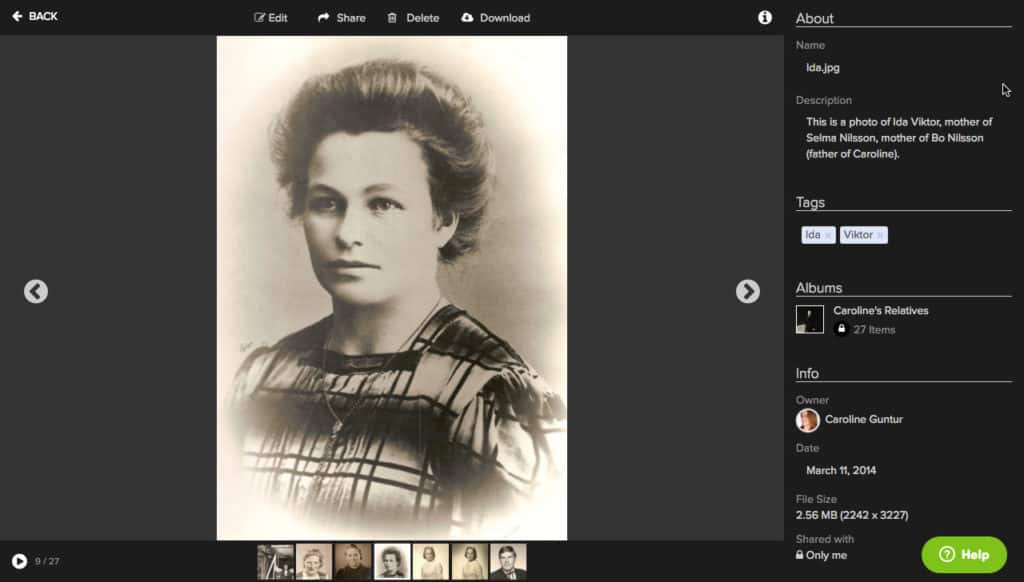
Forever is a great example of a complete family archive. Here’s a screenshot from my account, which shows just how many options you have when working with your photos!
It a family archive a bit pricier than the basic account? Yes, but you also get your money’s worth in terms of preservation and permanence. With this type of account, you’re not really paying for storage, you’re paying for better terms. Unlike your basic cloud accounts, you can expect to have privacy and control in a family archive. And more importantly, you’re often buying, not renting, your storage. Compare it to buying a house vs. renting an apartment. You’ll be able to curate something special for your descendants with an account like this. Instead of leaving them a mess, you’re leaving them a legacy. The two best examples are Forever, and FamilyArc.
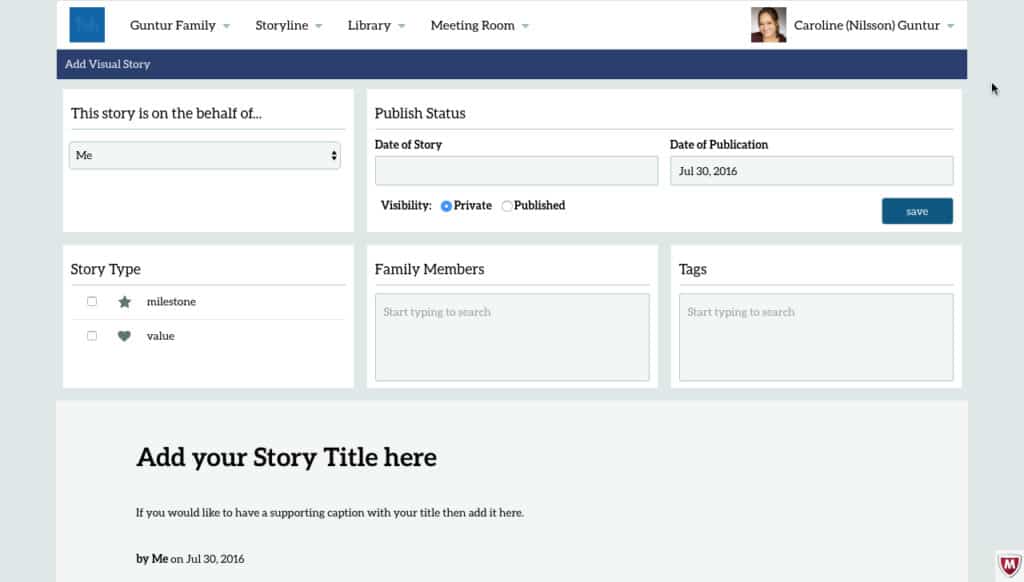
FamilyArc is another great example of a family archive that makes it easy to collaborate with relatives. You can chat, plan reunions, and as you can see here, easily publish your milestones, values, and stories for the family to enjoy.
I happen to love the complete family archives! They are suitable for every tech level because they are much more user-friendly than the basic ones. The organizational features alone are worth the investment, and it’s just so much more fun to be able to actually do something with your photos. Don’t you think?






Jenny Herrero
August 4, 2016 at 11:23 amThis is very enlightening! I’ve started archiving my family collection in forever.com, and am going to investigate FamilyArc further. So many of us have our photo files just sitting in a folder on an external hard drive, or our desktop…disorganized and not backed up! Forever.com and Family arc seem like great options for preserving high quality archive files, while preserving meta-data and the stories that come with the photos. Thanks for sharing!
Caroline Guntur
August 4, 2016 at 11:28 amThanks Jenny! Both Forever and FamilyArc are really great options, so definitely look into them! 🙂